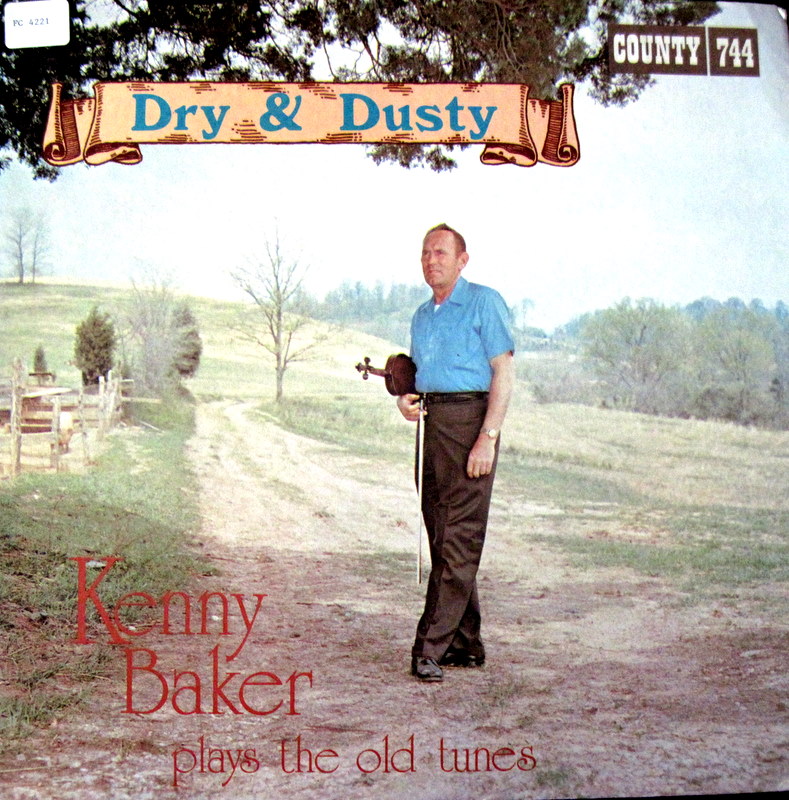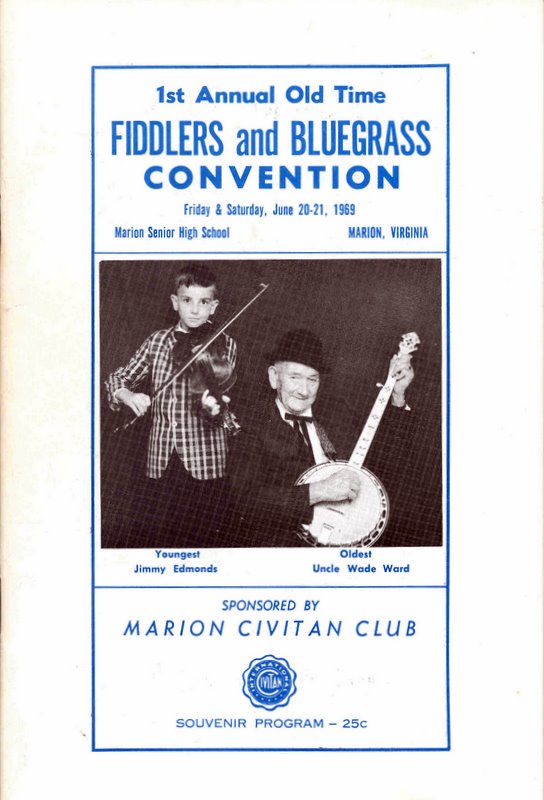
On Thursday October 20, 2011, the UNC Music Library will celebrate its seventy-fifth anniversary with the opening of an exhibition in the Melba Remig Saltarelli Room on the third floor of the Louis Round Wilson Special Collections Library. The exhibition, entitled “Curating Sound: 75 Years of Music Collections at UNC” will feature materials from the Music Library, the Southern Folklife Collection, and the Southern Historical Collection of the University Library. On display will be items as diverse as Palestrina prints, libretti from the Florentine Camerata, Lully manuscripts, historic sound recordings, rare concert posters, and even Andy Griffith’s guitar.
The exhibition will open with a reception at 5 pm, a keynote address by Prof. Tim Carter, the David G. Frey Distinguished Professor of Music, and a short concert featuring works from the collection, including ensembles performing English baroque, Old-time stringband, early rockabilly, and Irish traditional music.
While looking for items to contribute from the Southern Folklife Collection, these two 7-inch 45 rpm records (above and below) caught our eye and seemed worthy of further exploration. Above is the cover to Chants au pied de l’Annapurna [Chants at the foot of Annapurna], field recordings from central Nepal by Rene de Milleville–a french writer who lived in Nepal, specializing in the study of rhododendrons and orchids of the region. The following is a sample of the track “Sitarané” from side A.
“Sitarané” performed by musicians from central Nepal Sitarane`
From closer to home in the John D. Loudermilk Collection (#20148), we found a 45 rpm record from Chapel Hill’s own Colonial Records, owned and operated by Orville B. Campbell. Johnny Dee, the first recording moniker of country great John D. Loudermilk, was a student at Campbell College when he recorded “A-plus In Love.” featuring Joe Tanner on the guitar. North Carolina Collection Photographic Archives blog, A View To Hugh, has an excellent article on Loudermilk, and for a few more tracks see this Field Trip South post from two years ago. More information and updates on the exhibit to come, but for now, enjoy a little Johnny Dee.
“A-Plus In Love” by Johnny Dee A-Plus In Love_Johnny Dee
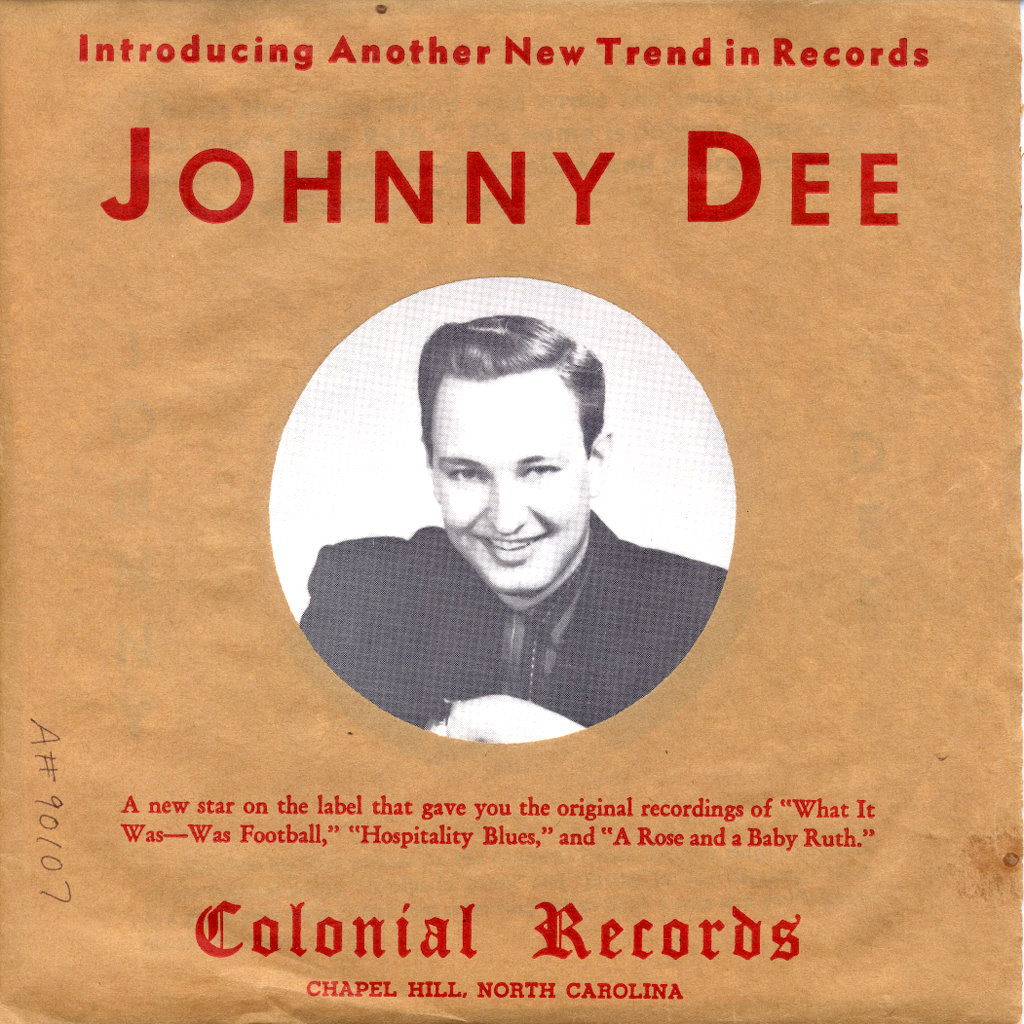
Category: Uncategorized
Happy Birthday, Mr. Coltrane
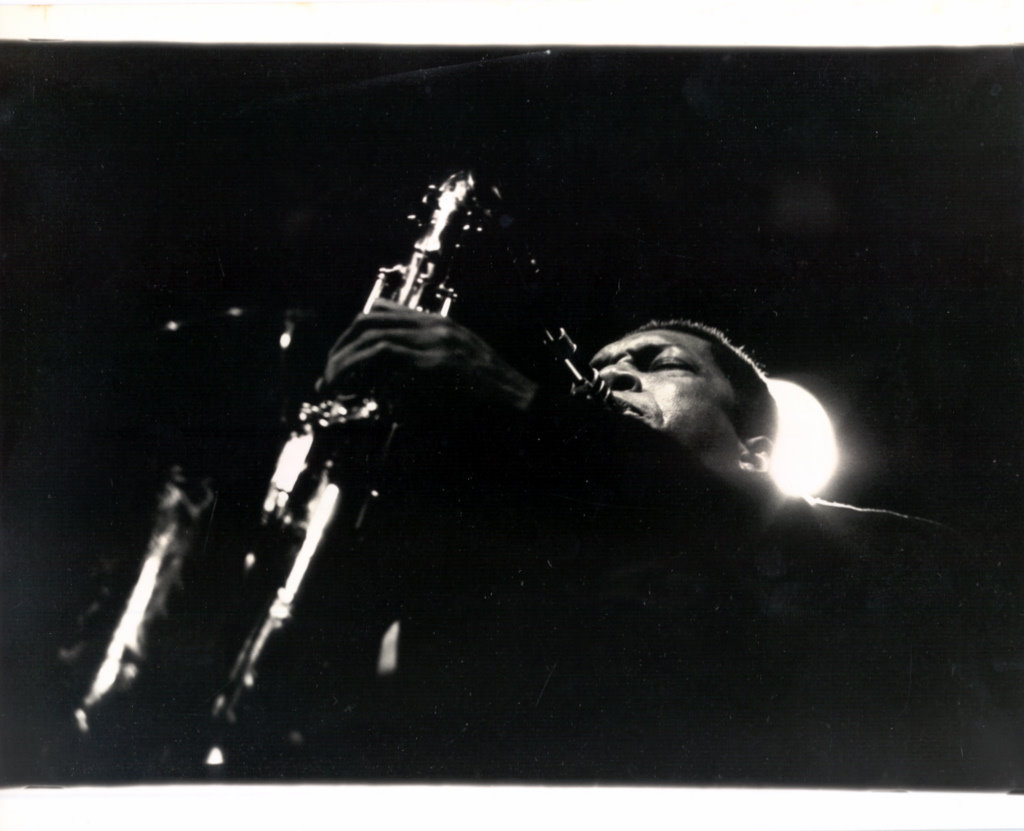 It has been a great week at the Southern Folklife Collection. We kicked off our series of symposia and concert tributes to American blues masters with an evening of Howlin’ Wolf to great success. We cannot thank our participants–Peter Guralnick, Knox Phillips, Alvin Youngblood Hart, Eddie Shaw and the Wolf Gang, Jody Williams, and Henry Gray–and the Friends of the Library organization at UNC enough. Our second event in the series, a tribute to Gary Davis, is scheduled for November 17, with a keynote by author and scholar Elijah Wald, and featuring musicians Stefan Grossman, Ernie Hawkins, and Jorma Kaukonen. More details to come but for now see this facebook event page.
It has been a great week at the Southern Folklife Collection. We kicked off our series of symposia and concert tributes to American blues masters with an evening of Howlin’ Wolf to great success. We cannot thank our participants–Peter Guralnick, Knox Phillips, Alvin Youngblood Hart, Eddie Shaw and the Wolf Gang, Jody Williams, and Henry Gray–and the Friends of the Library organization at UNC enough. Our second event in the series, a tribute to Gary Davis, is scheduled for November 17, with a keynote by author and scholar Elijah Wald, and featuring musicians Stefan Grossman, Ernie Hawkins, and Jorma Kaukonen. More details to come but for now see this facebook event page.
This morning we were looking through negatives of images photographed by Robert Bolton at the Downbeat Jazz Festival at Soldier Field, Chicago, Illinois,15 August 1965 to choose an item for an upcoming exhibit. While doing so, we were reminded that today, September 23, is John Coltrane’s birthday. Coltrane was born in Hamlet, North Carolina on September 23, 1926, and grew up in High Point, NC, attending William Penn High School (now Penn-Griffin School for the Arts). A successful effort to purchase and restore his childhood piano was completed in 2006 and the instrument now resides at the High Point Museum.
Besides tuning in for some excellent programming (24 hours of Coltrane) by Columbia University’s WKCR, we wanted to share a few of Bolton’s photographs of Coltrane from that day. These photos document an extraordinary performance–Coltrane invited Archie Shepp on tenor sax to join the quartet of himself, McCoy Tyner, Jimmy Garrison, and Elvin Jones–that marked a distinctive turning point in Coltrane’s career. Often compared to Bob Dylan’s “plugging in” at the Newport Folk Festival, 1963, Coltrane’s quartet plus Shepp closed the night, free and ferocious and in stark contrast to the more straight forward bebop played throughout the day.
These two images are held as part of the Robert Bolton Collection, 1955-1980 and undated, collection #20408. The Robert Bolton Collection consists chiefly of photographic materials documenting the social landscape of the eastern United States from the mid 1950s through the early 1980s. Bolton’s photographs examine everything from common street scenes found in and around many southern cities during the 1960s to cultural gatherings, such as the Downbeat Jazz festival in Chicago, Ill. and the Ole Time Fiddler’s & Bluegrass Festival in Union Grove, N.C. In addition, Bolton photographed numerous performers including Bob Dylan, John Coltrane, Louis Armstrong, and many others. Other materials included in the collection are 8mm films depicting Sports Car Club of America auto races from 1960 to 1961 and drawings and paintings created between 1959 and 1967.
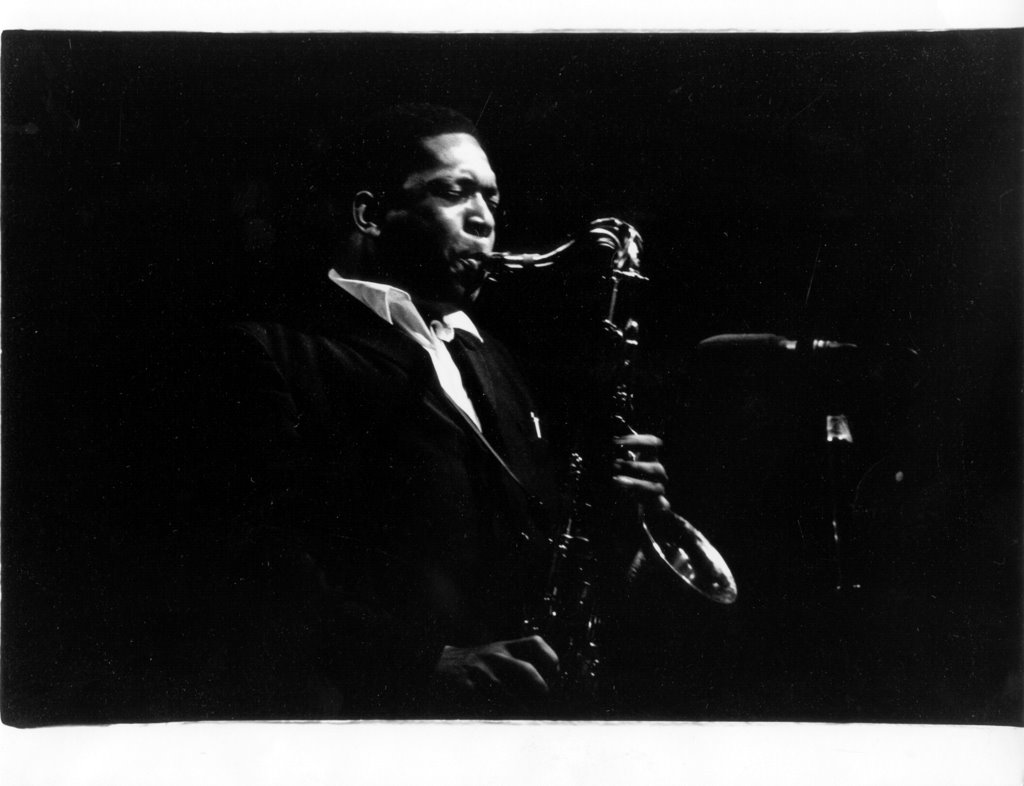
SFC Spotlight: Wade Mainer
![Call no. P925: Wade Mainer [ca. 1950s], Southern Folklife Collection, UNC Chapel Hill](https://blogs.lib.unc.edu/sfc/wp-content/uploads/sites/9/2011/09/p925.jpg) Wade Mainer [ca. 1950], Call no. P925, Southern Folklife Collection, UNC Chapel Hill
Wade Mainer [ca. 1950], Call no. P925, Southern Folklife Collection, UNC Chapel Hill
Country music lost one of it’s greatest practicioners this week when Wade Mainer passed away at the age of 104. Mainer developed a two-finger banjo style using finger picks, playing leads and melodic lines on the instrument previously used primarily as rhythm accompaniment. Beyond his musical abilities, Mainer long held a reputation as a skilled entertainer, generous mentor, and gracious to his fans.
The Southern Folklife Collection is the repository of many materials related to Wade Mainer, including a 1980 interview by David Holt, call no. FS-10717 in the David Holt Collection, research and recordings in the Bob Carlin Collection, as well as interviews, recordings and radio programs featuring Mainer produced by Paul Brown in the Paul Brown Collection. We were honored to host a program and tribute to celebrate the publication of Mainer’s biography last year, the excellent Banjo on the Mountain: Wade Mainer’s first 100 years, by Dick Spottswood. The SFC also holds many of Wade Mainer’s commercially released recordings. His career spanned most of the history of recorded music, a sonic record of his of his immeasurable influence on country, bluegrass and American music.
For an all to brief history of Mainer’s early career, we turn to music scholar and friend of Wade Mainer, Dick Spottswood, who wrote a touching obituary for his friend. Read the whole piece at WAMU’s BluegrassCountry.org:
![Call no. P923: J. E. Mainer's Mountaineers [Top left: Ollie Bunn; Rt: Zeke Morris; Bottom left: J. E.; Rt: Wade], Southern Folklife Collection, UNC Chapel Hill](https://blogs.lib.unc.edu/sfc/wp-content/uploads/sites/9/2011/09/p923-188x300.jpg) “Wade was one of the most remarkable musicians of his era. With his fiddling brother J.E. (1898-1971), Wade played music informally with and for fellow cotton mill workers in Concord, North Carolina starting in the 1920s. When they played over WSOC in Gastonia in 1932, the Mainers began a new career that would eventually allow them to become full time musicians, performing at night by gaslight in rural schools and getting up in time for 5 and 6 AM daily radio shows designed for working farmers to enjoy at breakfast before heading out for the fields. They graduated to WBT (Charlotte) in 1934, becoming Mainers’ Mountaineers when they were sponsored by Crazy Water Crystals, a Texas mineral water-derived concoction that hosted live country music from Oklahoma(Bob Wills) to Halifax (Hank Snow). The brothers split up in 1936 when J.E. elected to stay with Crazy Water and Wade chose to move on, calling his new outfit Wade Mainer and Sons of the Mountaineers. In 1937 he wed Julia Mae Brown of Mocksville, who had performed on radio herself as “Hillbilly Lily.”
“Wade was one of the most remarkable musicians of his era. With his fiddling brother J.E. (1898-1971), Wade played music informally with and for fellow cotton mill workers in Concord, North Carolina starting in the 1920s. When they played over WSOC in Gastonia in 1932, the Mainers began a new career that would eventually allow them to become full time musicians, performing at night by gaslight in rural schools and getting up in time for 5 and 6 AM daily radio shows designed for working farmers to enjoy at breakfast before heading out for the fields. They graduated to WBT (Charlotte) in 1934, becoming Mainers’ Mountaineers when they were sponsored by Crazy Water Crystals, a Texas mineral water-derived concoction that hosted live country music from Oklahoma(Bob Wills) to Halifax (Hank Snow). The brothers split up in 1936 when J.E. elected to stay with Crazy Water and Wade chose to move on, calling his new outfit Wade Mainer and Sons of the Mountaineers. In 1937 he wed Julia Mae Brown of Mocksville, who had performed on radio herself as “Hillbilly Lily.”
Before World War II, Wade, along with band members Zeke Morris, Steve Ledford, and Clyde Moody worked at ten more stations from Danville to New Orleans, and recorded more than a hundred titles for RCA Bluebird, including versions of Little Maggie, Little Birdie, Maple on the Hill, Old Reuben, Wild Bill Jones, John Henry, Down in the Willow Garden, On a Cold Winter’s Night (The Wreck of Number Nine), and Riding On That Train 45. The last four were selected by John Lomax for the influential 1941 RCA record album Smoky Mountain Ballads that introduced music from Wade Mainer, Uncle Dave Macon, the Monroe Brothers, Dixon Brothers and Carter Family to folk music fanciers up north. Wade’s records also sold well in the south, keeping his songs in repertory well into the bluegrass era, and keeping the unique sound of the fiddle and banjo alive all but single handedly until Bill Monroe hired Stringbean (1942) and Earl Scruggs (1945) to complement fiddlers and Bill’s own mandolin.
John’s son Alan Lomax liked Wade’s records too. He and Librarian of Congress Archibald MacLeish invited the Sons of the Mountaineers for an “Evening of American Folklore,” at the White House on February 17, 1941. Wade liked to tell about being accidentally hit by a swinging door and spilling a dish of ice cream on Eleanor Roosevelt. As he related,” I was standing right there and Mrs. Roosevelt went out for something. And when she came back she pushed the door open and it hit me and it knocked the bowl of ice cream out of my hand and knocked it on her.
“So I run my hand down in my pocket and pulled out a big old red bandana handkerchief, I was going to wipe the ice cream off of her. She said, ‘No, you just forget about that.’ She disappeared for a few minutes and directly she came back, she had on a different dress and everything. The concert went on and it was a very lovely evening we had down there with them at the White House.”
Alan Lomax then went to Asheville, where Wade and the band were broadcasting daily from WWNC. With staff announcer Marty Lyles, they recorded a simulated broadcast that concentrated on traditional material. In the fall, famed Life magazine photographer Eric Schaal went toVirginia,Tennessee and North Carolina to document Wade, the Carter Family and Bascom Lamar Lunsford for an article on country music, scheduled for the second week in December 1941. ButAmerica entered World War II that week, and the photo essay never appeared.
On November 19, 1941, Wade received a telegram from WSM’s George D. Hay inviting the Sons of the Mountaineers to the Grand Ole Opry inNashville. At the time they were the featured band on the Mid-Day Merry-Go-Round on WNOX inKnoxville. Producer Lowell Blanchard had the band under contract, and, after initially agreeing to let Wade go, held him to the contract’s terms. Wade never got to play the Opry until 2002, when he was hosted by Bill Anderson and Eddie Stubbs.”
Wade stepped back from music in the 1950s and relocated to Flint, Michigan, preferring to raise his family with a steady paycheck from General Motors. After his children were grown, however, he picked up the banjo again, performing with his wife Julia to new generations of fans and receiving the National Heritage Award in 1987.
We’ll share some more Wade Mainer material next week, but take a moment and remember one of America’s greatest musicians. Paul Brown wrote and recorded an obituary for NPR and William Grimes wrote for the New York Times.
SFC Spotlight: Back to school with Jimmy Boyd and the School for Workers
78-5076. Jimmy Boyd, “(I’ve got those “wake up, seven-thirty – wash your ears they’re dirty – eat your eggs & oatmeal – rush to school”) blues”[audio:https://blogs.lib.unc.edu/sfc/wp-content/uploads/sites/9/2011/08/78-5076_1.mp3|titles=78 5076_1_Jimmy Boyd]
School is back in session here at UNC, and we are more happy about that than the incomparable Jimmy Boyd (probably best known as the amazing voice of “I Saw Mommy Kissing Santa Claus”). Boyd recorded this tune in 1953, one of a number of popular country and novelty tunes he recorded for Columbia throughout the 1950s, including duets with Rosemary Clooney and Frankie Laine. While some of the novelty tunes have not aged terribly well, this track is country pop candy with the Norman Luboff Choir and pedal steel likely performed by the equally incomparable Speedy West.
Steel solo, 78-5076. Jimmy Boyd, “(I’ve got those “wake up, seven-thirty – wash your ears they’re dirty – eat your eggs & oatmeal – rush to school”) blues”[audio:https://blogs.lib.unc.edu/sfc/wp-content/uploads/sites/9/2011/08/78-5076_2.mp3|titles=78 5076_2]
We have an exciting fall of projects and programs ahead. “From the Cradle to the Cave,” our exhibit of North Carolina poster art from the SFC collections opened last week in Davis Library and will hang until next may. It was an excellent event with all five artists present and sweet sounds courtesy of The Kingsbury Manx.
Tickets are on sale for our concert tribute to Howlin’ Wolf. Scheduled for September 19 in the Great Hall of the UNC Student Union, the concert will feature Alvin Youngblood Hart, Eddie Shaw and the Wolf Gang, Jody Williams, and Henry Gray. Prior to the concert, a free public symposium will take place in Wilson Library. At 5:30 p.m., blues scholar Peter Guralnick will discuss Howlin’ Wolf’s life and music. Guralnick is currently writing a book about Sam Phillips, the Sun Records founder who discovered not only Howlin’ Wolf, but also Elvis Presley, Jerry Lee Lewis, and Johnny Cash.
Guralnick will then be joined for a Q&A conversation with Phillips’s son Knox Phillips, who learned the music business from his father before embarking on his own career as an engineer, producer, and studio owner. The concert is the first in a series of blues tributes hosted by the Southern Folklife Collection in 2011 and 2012.
 In honor of the first Monday of the school year, we wanted to share some items to inspire the coming work ahead. What better inspiration than Labor Songs for All Occasions, produced by The School for Workers at the University of Wisconsin in 1940. Part of the SFC Song Folios Collection #30006, circa 1882-1983, call no. FL-409.
In honor of the first Monday of the school year, we wanted to share some items to inspire the coming work ahead. What better inspiration than Labor Songs for All Occasions, produced by The School for Workers at the University of Wisconsin in 1940. Part of the SFC Song Folios Collection #30006, circa 1882-1983, call no. FL-409. 
There are songs for all occasions, “March of the Toilers,” for walking to classes, “Soup Song” for trips to Lenoir, “Put on Your Smart Now Bonnet” for homework and test preparation, and “We’ll Not Be Fools” as and “The Cudgel Song” for mid-term exams and finals. Choose your favorite from the the contents below.

From the Cradle to the Cave: 18 Years of North Carolina Poster Art
Five poster artists who have helped define the Chapel Hill music scene will see examples of their work on exhibit in Davis Library beginning Aug. 25.
From the Cradle to the Cave: 18 Years of North Carolina Poster Art will be on view on the main floor of Davis Library through Jan. 25, 2012. The exhibit will feature 40 reproductions of posters by Casey Burns, Matt Hart, Ron Liberti, Jason Lonon, and Chris Williams, dating from 1993 onward.
An opening program Aug. 25 at 5:30 p.m. will feature the artists in conversation about their work, following a 5 p.m. reception. The free public event will conclude with a concert by Chapel Hill band The Kingsbury Manx.
The artists have played an important role in advertising local concerts. Many of their posters and fliers have promoted events at venues such as Cat’s Cradle, Local 506, and the now closed Go! Room 4.
The Southern Folklife Collection in the Wilson Special Collections Library holds the archives of all five artists, including original poster art. The Burns, Liberti, and Lonon collections are currently available for use; those of Hart and Williams will be available in 2012. Burns is a 1998 graduate of UNC.
The event is sponsored by the Southern Folklife Collection in Wilson Library, the University Library Public Art Committee, and the Friends of the Library,.
From the Cradle to the Cave: 18 Years of North Carolina Poster Art
On view Aug. 25, 2011 – Jan. 25, 2012
Exhibit Opening: Thursday, Aug. 25, 2011
Davis Library Gallery
5 p.m. Reception
5:30 p.m. Panel with Casey Burns, Matt Hart, Ron Liberti, Jason Lonon, Chris Williams
6 p.m. Concert with Chapel Hill band The Kingsbury Manx
Free and open to the public
Information: Steve Weiss, Southern Folklife Collection, (919) 962-1345
View the Facebook event for this program
SFC Spotlight: Bo Diddley is a Gunslinger
 Bo Diddley is a Gunslinger, call no. FC-4503, definitely ranks high on at our list of all time greatest album covers. Diddley looks fast and dangerous, and the music fits the bill. Did you know Bo Diddley is a gunslinger? Just listen to the title track and there will be no doubt.
Bo Diddley is a Gunslinger, call no. FC-4503, definitely ranks high on at our list of all time greatest album covers. Diddley looks fast and dangerous, and the music fits the bill. Did you know Bo Diddley is a gunslinger? Just listen to the title track and there will be no doubt.
“Gunslinger” from FC-4503, Bo Diddley is a GunslingerFC_4503_Bo Diddley_Gunslinger
For more Bo Diddley, we thought readers might enjoy a brief interview conducted by Eddie Weiss, a lifelong East coast radio announcer, perhaps best known for his programming of Beach music under the DJ handle “Charlie Brown.” Throughout the 1950s, Weiss and fellow DJ Ronny King interviewed recording stars for their Tidewater, Virginia radio programs “WAVY’s Your Show,” and “Tidewater Teen Time” any chance they could get–-from Bobby Darin, Clyde McPhatter, and Ahmad Jamal, to Carl Perkins, Marty Robbins and Frankie Lymon. Luckily, one afternoon Bo Diddley stopped by and explained the spiritual roots of his music. Not sanctified necessarily, but spiritual. We hear you Bo.
Bo Diddley interview by Eddie Weiss from FT_1305117 Bo Diddley interview_FT13051
SFC Spotlight: Kenny Baker
**click photo to enlarge**
World renowned fiddler Kenneth Clayton Baker of Jenkins, Kentucky passed away on July 8, 2011. Master of the “long bow” style of bluegrass fiddling, Baker joined up with Bill Monroe in 1957, becoming the longest lasting member of The Bluegrass Boys when he left the group in 1984. Best known as a bluegrass fiddler, Baker’s reputation as a musician reached far beyond bluegrass into swing, country, and beyond, earning him a National Heritage Award from the National Endowment for the Arts in 1993. Baker’s influence on American music is immeasurable.
We are fortunate to hold a wide array of Baker’s recordings a the Southern Folklife Collection spanning his entire career, including his fantastic solo LPs of fiddle tunes recorded for the County label in the 1970s, like Dry and Dusty, call no. FC_4221, pictured above. The Becky Johnson Collection (#20405) includes some wonderfully candid performance photos of Baker and countless other bluegrass heroes, and the always astounding collection of materials assembled by the late Mike Seeger includes priceless recordings of performances by Baker and his fellow Bluegrass Boys.
While scanning through Seeger’s recordings, we came across a bluegrass fiddling workshop hosted by Seeger at Bill Monroe’s Bean Blossom festival, 21 June 1969, call no. FT_12857. In the two clips below, Baker first expresses his love for the fiddling of legendary jazz violinist Stéphane Grappelli, and in the second, we are treated to Baker’s rendition of the classic fiddle tune “Fisher’s Hornpipe.” May he rest in peace.
Kenny Baker, workshop at Bean Blossom, 21 June 1969FT_12857_Kenny Baker_Stéphane Grappelli
Kenny Baker, “Fisher’s Hornpipe,” live at Bean Blossom, 21 June 1969FT_12857_Kenny Baker_Hornpipe
Photo and Folio of the Week: Eddy Arnold on stage, in person, and on screen
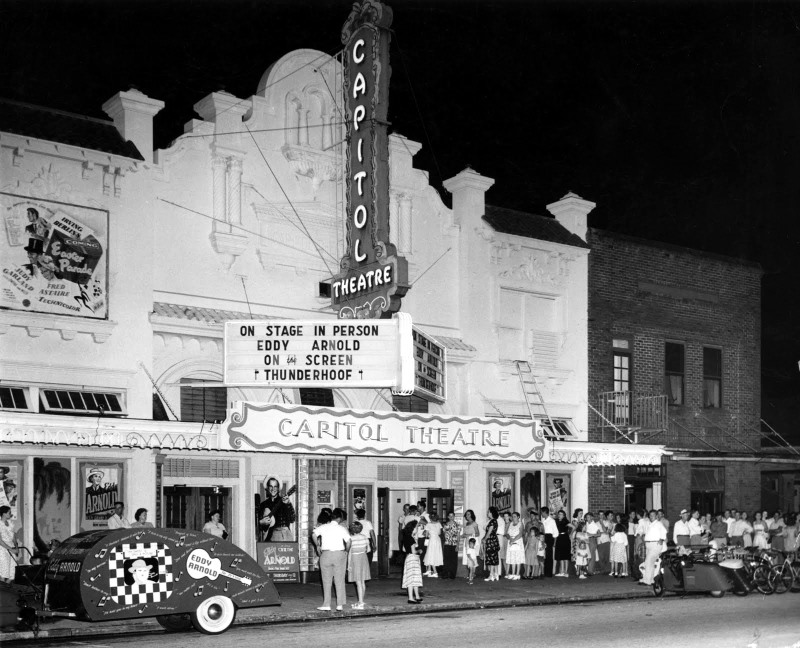 **click image to enlarge**
**click image to enlarge**
This photograph is fascinating as a document of concert goers in the late 1940s, however the band trailer for Eddy Arnold parked out front is what constantly piques my imagination. With the white wall tires and custom paint job, featuring a portrait of Arnold himself as well as the titles of his countless hit songs, I know I’d bee excited to see this barreling down the freeway with Arnold behind the wheel.
We are not sure in which city this photo was taken as there were countless Capitol Theatre’s across the United States, however, we do know Thunderhoof–starring Mary Stuart, Preston Williams, William Bishop, and of course, Thunderhoof as himself–appeared in theaters in 1948 when Eddy Arnold was at the peak of his 1st stage of Country music stardom.
Arnold recorded over 60 top ten hits for RCA throughout the 1940s, under a contract managed by the infamous Colonel Tom Parker. In 1948 he had five songs in the top 10 simultaneously and Arnold held the number 1 spot for 40 weeks of that year. Not sure how much merchandise artists sold on tour back then, but maybe had a few of these song folios, call no. FL-199 from the ever popular Southern Folklife Collection Song Folios, circa 1882-1983 (#30006) , on hand for fans.

Eddy Arnold’s Favorite Songs. Hill and Range Songs, Inc. New York, N.Y. 1948. 44 p. of music and illustrations.#30006, Series: “Song Folios, circa 1882-1983.” FL-199
“Just a Little Lovin'”
“Anytime”
“Bouquet of Roses”
“Molly Darling”
“Chained to a Memory”
“Detour”
“Drivin’ Nails in My Coffin”
“No Children Allowed”
“Dangerous Ground”
“Rose of the Alamo”
“At Least a Million Tears”
“Can’t Win, Can’t Place, Can’t Show”
“False Alarm”
“Who at My Door Is Standing?”
“He Knows”
Photo of the Week: The DeZurik Sisters
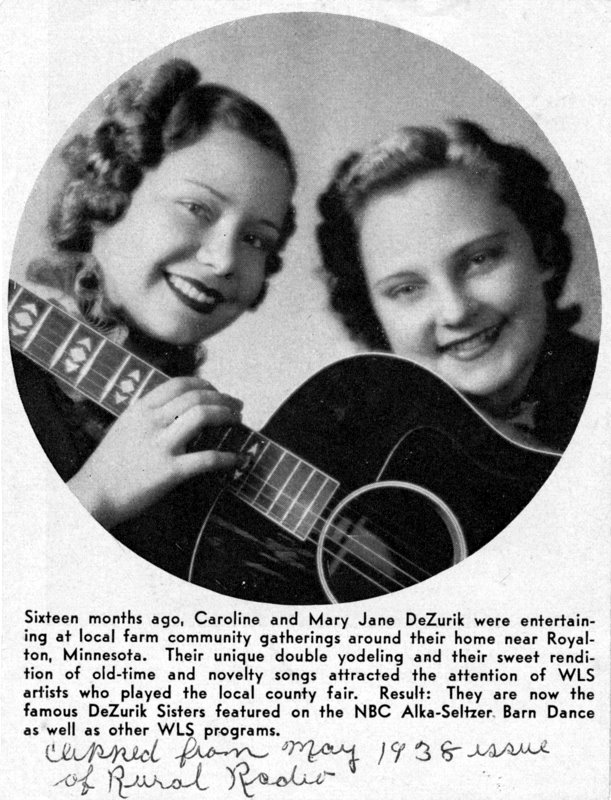 A wonderful 1938 promotional photo of the fantastic yodeling DeZurik Sisters early in their career. Photograph from the John Edwards Memorial Foundation Collection (#20001).
A wonderful 1938 promotional photo of the fantastic yodeling DeZurik Sisters early in their career. Photograph from the John Edwards Memorial Foundation Collection (#20001).
SFC Spotlight: Alva Greene, Fiddler's Conventions, and Guthrie T. Meade
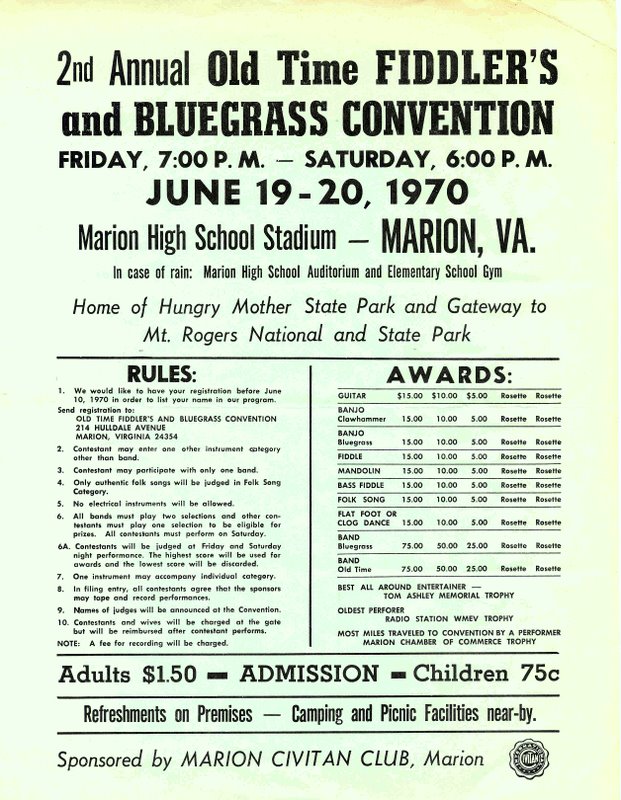 2nd Annual Old time Fiddlers and Bluegrass Convention, 1970, Marion, VA. Guthrie T. Meade Collection, 1817-1991 (#20246). Subseries 6.4. Fiddle Contests and Conventions: General, 1889-1979. Folder 197: 1960s-1990s.
2nd Annual Old time Fiddlers and Bluegrass Convention, 1970, Marion, VA. Guthrie T. Meade Collection, 1817-1991 (#20246). Subseries 6.4. Fiddle Contests and Conventions: General, 1889-1979. Folder 197: 1960s-1990s.
While looking for information about the great Kentucky fiddler Alva Greene, recorded by Kevin “Chris” Delaney (see SFC tapes call nos. FT-284 and FS-7169) as well as Guthrie Meade and Mark Wilson in the 1970s, I had the opportunity to spend a brief moment with a few of Guthrie Meade’s vast fiddle files.
“Grampaw” performed by Alva Greene, from SFC open reel tape call no. FT-284, side 1. Recorded by Chris Delaney at Mr. Green’s home in Sandy Hook, Kentucky, Sept. 20 1973. Mr. Green was 78 years old at the time of the recording. He was born in Elliot Co., Kentucky. For a fuller fiddle fix, hear more recordings of Alva Greene by Delaney at the Digital Library of Appalachia.
A seemingly inexhaustible scholar, Meade was constantly developing his discographical research, as documented by a page from this early 1970s spiral notebook (below). The notebook also chronicles some of Meade’s 1970s fieldwork exploring his lifelong interest with fiddling contests and fiddlers conventions so we pulled out a few fliers and programs from Meade’s festival files, including the “Creed of Civitan” according to the Marion Civitan Club, to share with you as well (further below). Our continuing tribute to Hazel Dickens will conclude next week. Have a great weekend.
** CLICK IMAGES TO ENLARGE **
 Fieldnotes, Guthrie T. Meade, 1970s. Guthrie T. Meade Collection, 1817-1991 (#20246). Subseries 6.3. Kentucky Fiddling, 1919-1990. Folder 178: Kentucky fiddlers and tunes: General research
Fieldnotes, Guthrie T. Meade, 1970s. Guthrie T. Meade Collection, 1817-1991 (#20246). Subseries 6.3. Kentucky Fiddling, 1919-1990. Folder 178: Kentucky fiddlers and tunes: General research
Program, 1st Annual Old Time Fiddlers and Bluegrass Convention, Marion, VA, 1969. Guthrie T. Meade Collection, 1817-1991 (#20246). Subseries 6.4. Fiddle Contests and Conventions: General, 1889-1979. Folder 197: 1960s-1990s.
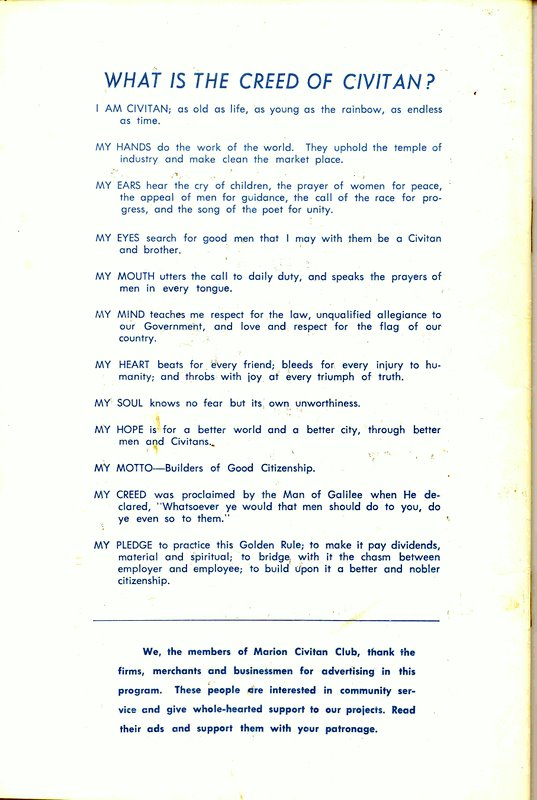 “Civitan Creed,” back of program, 1st Annual Old Time Fiddlers and Bluegrass Convention, Marion, VA, 1969. Guthrie T. Meade Collection, 1817-1991 (#20246). Subseries 6.4. Fiddle Contests and Conventions: General, 1889-1979. Folder 197: 1960s-1990s.
“Civitan Creed,” back of program, 1st Annual Old Time Fiddlers and Bluegrass Convention, Marion, VA, 1969. Guthrie T. Meade Collection, 1817-1991 (#20246). Subseries 6.4. Fiddle Contests and Conventions: General, 1889-1979. Folder 197: 1960s-1990s.
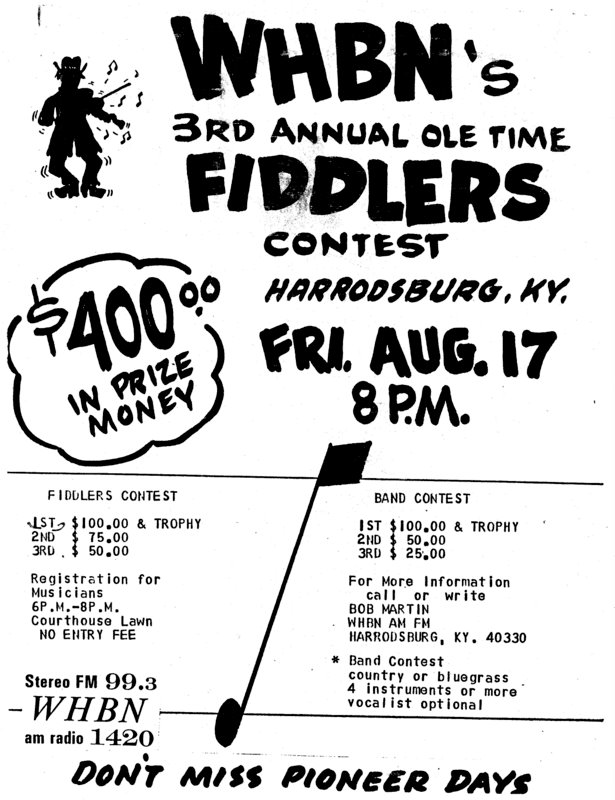 Flier, WHBN’s 3rd Annual Ole Time Fiddlers Contest, Harrodsburg, KY, 1990. Guthrie T. Meade Collection, 1817-1991 (#20246). Subseries 6.4. Fiddle Contests and Conventions: General, 1889-1979. Folder 197, 1960s-1990s.
Flier, WHBN’s 3rd Annual Ole Time Fiddlers Contest, Harrodsburg, KY, 1990. Guthrie T. Meade Collection, 1817-1991 (#20246). Subseries 6.4. Fiddle Contests and Conventions: General, 1889-1979. Folder 197, 1960s-1990s.
 Registration form, WHBN’s 3rd Annual Ole Time Fiddlers Contest, Harrodsburg, KY, 1990. Guthrie T. Meade Collection, 1817-1991 (#20246). Subseries 6.4. Fiddle Contests and Conventions: General, 1889-1979. Folder 197, 1960s-1990s.
Registration form, WHBN’s 3rd Annual Ole Time Fiddlers Contest, Harrodsburg, KY, 1990. Guthrie T. Meade Collection, 1817-1991 (#20246). Subseries 6.4. Fiddle Contests and Conventions: General, 1889-1979. Folder 197, 1960s-1990s.




